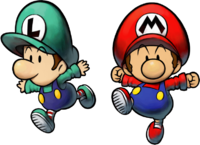Prerelease:Mario & Luigi: Partners in Time
This page details prerelease information and/or media for Mario & Luigi: Partners in Time.
Development Timeline
- 2005
- May 18th to the 20th. E3 takes place and Partners in Time, then known as Mario & Luigi 2, is announced with a 30-second long trailer and some footage of an early demo build. A press kit containing early promotional material is also handed out. The game itself was playable at E3, with two Nintendo DS systems available to test the game for a couple minutes.[1] A total of three levels were available: Toadwood Forest, Vim Factory, and Yoshi's Island, each of these levels giving the player an objective to complete the level (collecting stars, defeating Swiggler, and collecting a golden egg, respectively).[2]
- Date uncertain. A US kiosk demo is released, with a slightly more finalized EU version coming down the line.
- November 28. Partners in Time is released in North America.
- December 29. Partners in Time is released in Japan.
- 2006
- February 10. Partners in Time is released in Europe.
- February 23. Partners in Time is released in Australia.
- 2010
- July 8. Partners in Time is released in Korea.
May 2005
E3 2005
A press kit containing some artwork and a grand total of 15 screenshots taken from an early Japanese build of the game, even earlier than the one in the trailer, as it turns out.
Artwork Differences
| E3 Logo | Final Logo |
|---|---|

|
Included in the press kit is this early logo, which only refers to the game as "Mario & Luigi 2". Internationally, each new entry in the "M&L" series is given a unique name, while in Japan they are all known as "Mario and Luigi" followed by a number. In this case, Partners in Time is known as "Mario&Luigi RPG 2×2".
Artwork for both Baby Mario and Baby Luigi, where Baby Mario’s shoes are colored red instead of blue. This was more likely a mistake than an early design, seeing how Baby Luigi’s shoes are green and not blue. This piece of concept art would go on to be fixed and used on the Japanese microsite and kiosk demos for the game, while subsequent artwork of Baby Mario shows his shoes as correctly colored.
Screenshots
General Differences
The action icons were redesigned and given a smaller font, namely the status bar for the active brothers, which had bigger, italicized numbers and showed pink hearts instead of Mario and Luigi’s heads (the latter being a design remnant from Superstar Saga). This build of the game also has an L button icon with a yellow label that reads "Change" in Japanese. It appears that the original plan was to have the L button switch between sets of brothers instead of pressing Y or X for the babies and B or A for the adults. In the final game the L button allows the player to go through the different Bros. actions.
Hollijolli Village
| Early | Final |
|---|---|
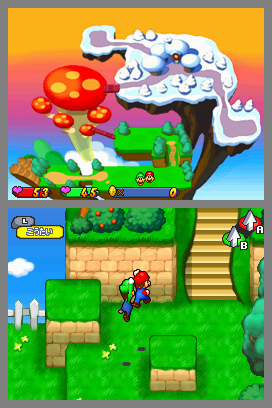
|
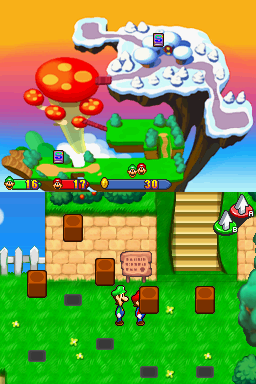
|
The entrance to Hollijolli Village. This version lacks the sign against the Save Albums, the sign against the wall and the M/L blocks; the stairs are also curvier and there are platforms not found in the final version.
| Early | Final |
|---|---|
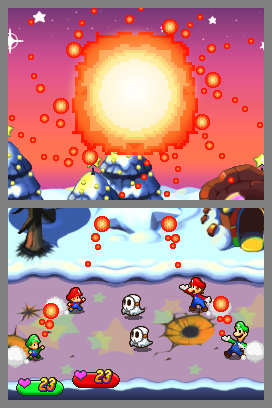
|
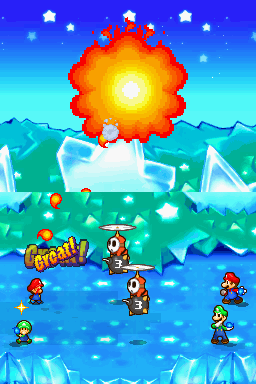
|
The Bros. having a fight in Hollijolli Village. In the final game, Boo Guys don’t appear in this area, and the Mix Flower was given a visual overhaul. It's possible that the Mix Flower had a different way of using it altogether at this point, seeing how the Bros. are not only placed differently, but are also shooting at the same time. In the final game, only one brother can shoot at a time.
The HP bar is also styled differently, not being aligned and using heart icons, and it shouldn't even appear here to begin with...
Toadwood Forest
| Early | Final |
|---|---|
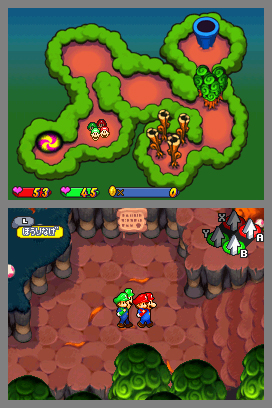
|
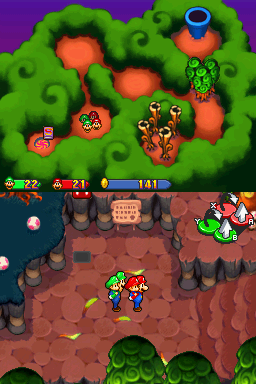
|
The group near the start of Toadwood Forest. The roots appear to lack the green "vim flow" animation, while on the top screen an early version of the mini-map is displayed, complete with a missing Save Album, a cruder Time Hole graphic, and a Blue Pipe with minor shading differences. The M block is also missing, while the mushroom right next to the jump icons has some slightly different shading too.
It's also worth noting that the adult Bros' icons lack shading in this screenshot and the two ones following it, revealing that not all of these are from the same build.
| Early | Final |
|---|---|
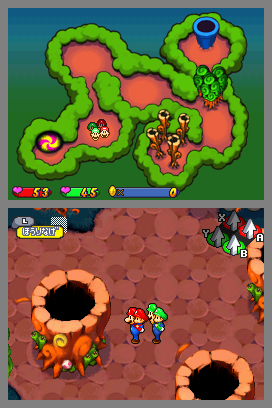
|
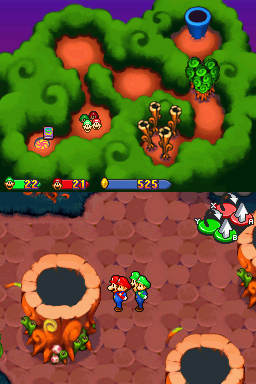
|
The sprites for the stumps were partially redrawn, namely the rim, while a few plants were added near the roots (with some of the plants having different shading than their final counterparts). The roots still aren’t animated. The "Change" button also has a strange white dithered square next to it; it’s unknown what this would have meant.
| Early | Final |
|---|---|
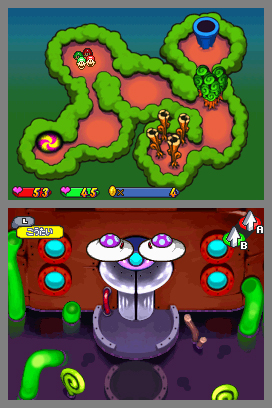
|
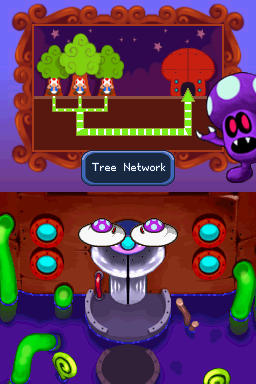
|
The cutscene where Toadiko tells the Bros. what's going on in Vim Factory. In the final game, the mini-map isn’t shown, instead being replaced by an animation showing Toads having their life force drained. The shot of the entrance to the factory is also rather different in a multitude of tiny ways: the water is way more dull and actually seems to reflect the light coming from the windows, the base of the tubes were given a shadow, the sprites for the entrance gate were redrawn slightly, and the sprites for the metal platforms have slightly different shading.
One of the tubes was also given a hole in the wall, a mushroom-shaped ripple was removed, and the red cable as well as some of the Shroobs' head spots were partially redrawn. Additionally, the HUD shouldn’t appear in this scene.
| Early | Final |
|---|---|
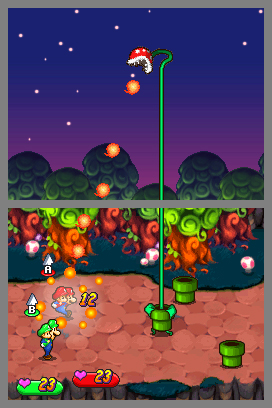
|
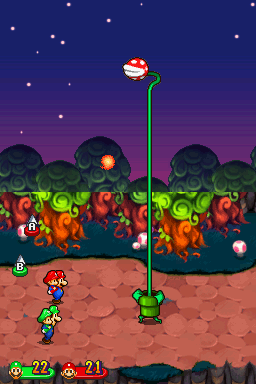
|
A fight against a group of Elasto Piranhas. In the final game, this enemy only shoots one fireball when attacking. The top screen's background is one pixel higher than in the final, and has some minor shading differences in the sky and trees.
| Early | Final |
|---|---|
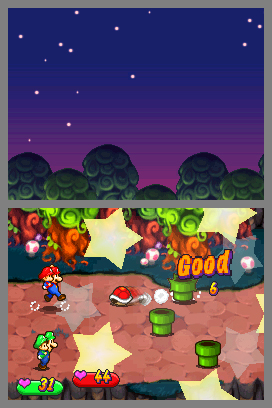
|
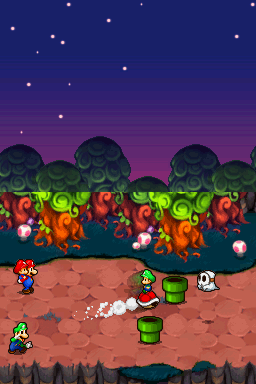
|
At this point in development, the babies didn’t ride on the Koopa Shell, instead just remaining on the back of their adult counterparts. Some stars were moved in the top-right portion of the screen, which wasn’t the case in the previous screenshot, and the spiky box behind the amount of damage inflicted is missing. The HP bar also shouldn’t appear here.
| Early | Final |
|---|---|
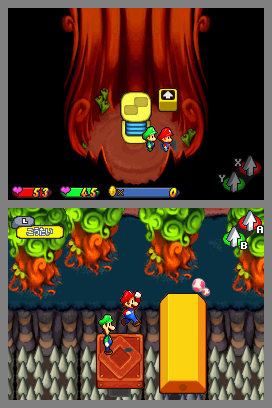
|
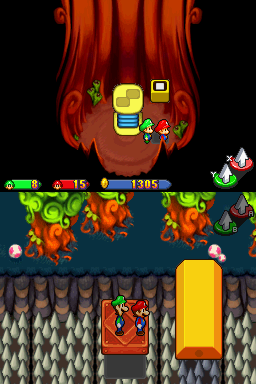
|
The babies guiding their adult selves safely across the spikes. Here you can see the early HUD once again, as well as a Baby Trampoline and Cruise Block with slightly different shading.
| Early | Final |
|---|---|
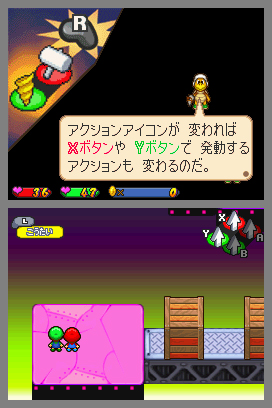
|
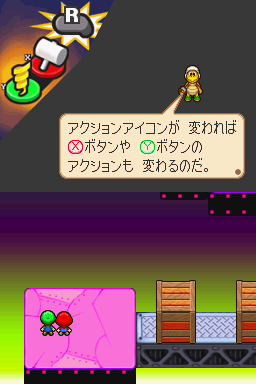
|
The Hammer Bros' tutorial. In the final version the background art was made smoother, the background became gray instead of black, the text box was moved slightly, and the breakable boxes were given some gray pixels on their corners. The X and Y icons were also redrawn, causing the sentence to be reworded, going from "As the action icon changes, you can also change the action operated by the button X or Y." to "As the action icon changes, you can also change the action of the button X or Y." The HUD also shouldn’t appear in this scene.
| Early | Final |
|---|---|
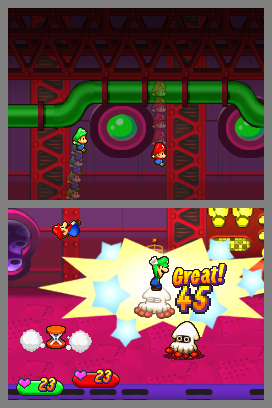
|
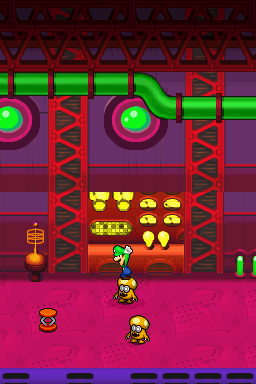
|
The group in Vim Factory fighting against a Scoot Bloop, an unused Blooper enemy whose data and graphics still remain in the final game, albeit in an incomplete form. This screenshot also shows that the player once faced the other way around when using the Trampoline (which uses a slightly cruder sprite here) and that the background was lined up differently. The HP bar also shouldn’t appear here.
Yoshi’s Island
| Early | Final |
|---|---|
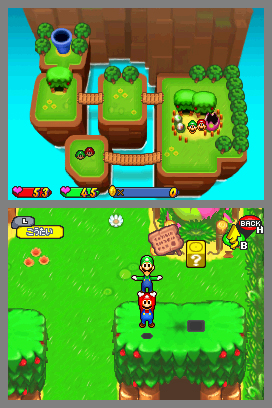
|
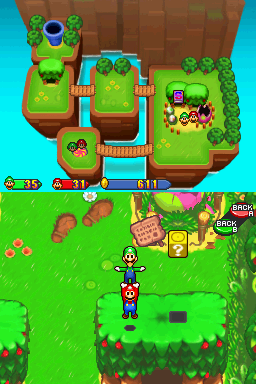
|
The Bros. beside Yoob’s egg. In the final version, footprints were added near the egg, probably to emphasize that what used to be inside hatched and ran away. The lowest "grass spot" was made bigger, and the Save Album and Time Hole are missing.
| Early | Final |
|---|---|
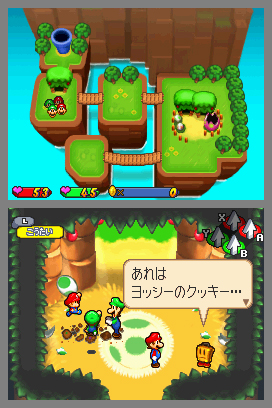
|
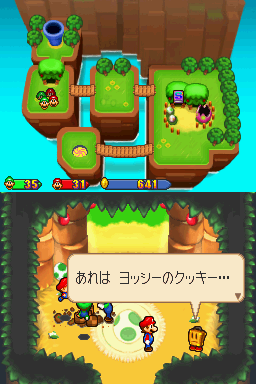
|
The Babies feasting on Yoshi cookies. The rug, the egg leaning against the wall, and the egg debris were redrawn in the final game (with some egg shells also being removed), while the cookies themselves were added. Stuffwell’s sentence was also made to fit into one line. The HUD shouldn’t appear in this scene either, and the Save Album and Time Hole are missing again.
| Early | Final |
|---|---|
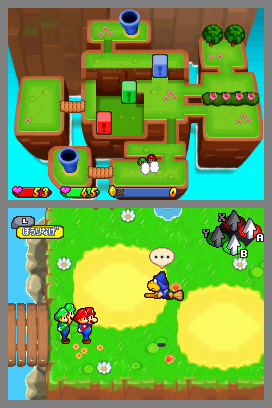
|
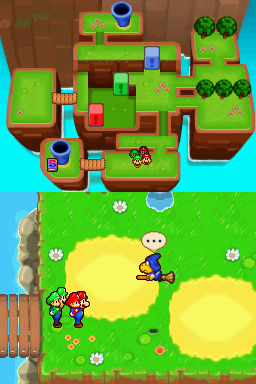
|
Kamek having a chat with the Bros. In the final version his hood and broom were redrawn, and so were the three trees on the top screen map, which at this point in development was a row of bushes with flowers on it (this was probably changed in order to make it more consistent with the other trees used on the minimap).
While the early screenshot is a little compressed (like all the others from the press kit), it does seem to showcase a lot of minor shading differences on the mini-map. The HUD also shouldn’t appear in this scene, and the Save Album is missing.
| Early | Final |
|---|---|
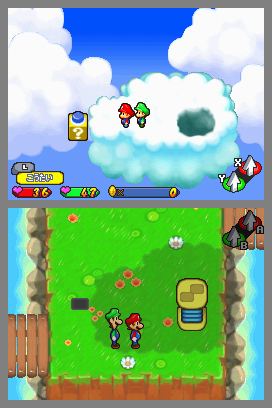
|
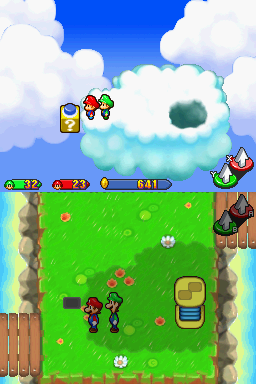
|
The Babies on one of the cloud platforms. Here you can see that the Baby Trampoline was moved a little and that the water was given different shading; additionally, the early HUD can be seen yet again.
| Early | Final |
|---|---|
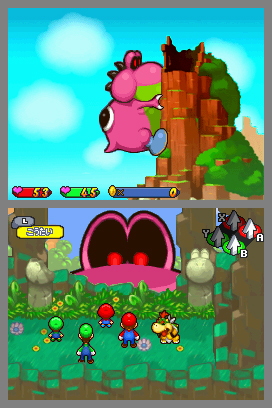
|
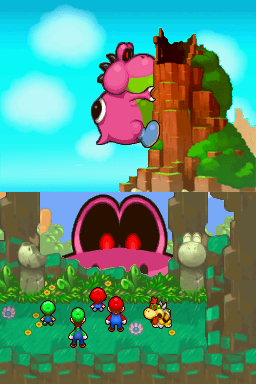
|
Yoob glaring hungrily at the group. In the final version it was given nostrils and its pupils were redrawn and made bigger. Luigi's left foot also appears behind a piece of scenery instead of in front of it, Mario is closer to Baby Bowser than in the final, and the damaged Yoshi statue was redrawn slightly, giving it more complex shading and a nostril unlike that of its undamaged equivalent. The HUD also shouldn’t appear in this scene.
Trailer
General Differences
The HUD is in an intermediary state: the action icons have their final design, but the two grayed-out jump graphics are still used when the babies are piggybacking, instead of the curved arrows used in the final game. The "Change" bar was recolored blue (and the graphics for it are still in the final game), while the early font and heart icons remained untouched. The spiky box is still missing, and so are the Save Albums, as seen at 0:03 in Toad Forest or at 0:12 and 0:23 in Yoshi’s Island.
Audio-wise, the sound made when the Babies are thrown and the one when they fall down the stump are different, and so are the sounds made when the Bros fall down when using the Trampoline, when they enter a green pipe, or when they manage a "Great" combo.
Toadwood Forest
The stumps still use their early sprite, but the roots are now animated. Moreover, while the mini-map was finalized, the blue pipe is missing from its normal position and is instead where the Time Hole normally is. A star counter can also be seen, which is one of the requirements to complete the Toadwood Forest area in the kiosk demo; another thing shared with the demo here is the fact that the player only has to find three flames instead of six (as evidenced by the missing glass block at 0:03).
Unused Bros. Item
At the 0:14 mark the player can be seen using a cut Bros. Item, the Spiny Shell, which as seen in this footage would have worked like the regular Green and Red Shell attacks except for it being hammered instead of kicked. Some unused graphics for this attack still exist in the final game. Two Scoot Bloops can also be seen being attacked during that section.
2005
Early Demo Footage
General Differences
Footage of an earlier version of the kiosk demo than the ones we have access to. From an event in 2005, although not E3. The main difference is that in this build the "Change" icon was localized, and is known as "toss" when the Babies are thrown, and then "switch" as long as the Babies are separated from the adult selves. The "curved arrow" graphics are also still not implemented, while the early stump sprites and heart icons/fonts still are. Still on the topic of graphical differences, the Babies are on their adult counterparts' back when the Koopa Shell attack is used, and the out-of-battle fade uses a warping effect instead of one reminiscent of the into-the-battle effect. The enemies' death animation also lacks its stars.
When in battle, the "Left / Right: Choose" option is stylized as "Left/Right: Choose", while the "Use (the D-pad) to select the BACK Block and confirm with L to return." text is simply rendered as "Select BACK, confirm". The Bros. item block is known as "Attack Item", and once in the menu (which uses an early window design reminiscing of the one in Superstar Saga) the attacks have "4-man Item" or "2-man item" on the selection screen depending on the number of Bros. needed for the move in question. At that point of the video it’s also possible to see that the Trampoline was placed before the Red Shell, which isn’t the case in the final game (speaking of the Trampoline, it still works like in the trailer, early sound effect and all).
Toadwood Forest
The intro message got some minor alterations between this build and the one we currently have access to, namely "Let’s find all of the stars" being written instead of "Let’s find all 5 stars". Another text difference can be found with the Koopeleon enemy, which back then was known as "Neanderkoopa".
Yoshi’s Island
A level which was showcased quite a lot in the press kit, but strangely doesn’t appear in any of the builds of the kiosk demo we have access to. Much like with Toadwood Forest and Vim Factory the Save Album is missing, and like these levels this one also has an introductory message, stating "This is where the Yoshis live, beautiful Yostar Island... What we've got to do is find the golden egg that's up atop the Island cliffs!".
In the following room there is a Coconutter not found in the final game, and the short cutscene with Kamek being surprised by the Bros. is missing. In the second room, the Pidgit is missing. Seeing how the footage ends abruptly, it's unknown what any other changes to the area might have been, though a written report of E3 2005 does confirm that the Kamek battle was present in this version. Regarding the "golden egg", whose graphics remain intact in the final game's files, we can infer that it could be collected after the Kamek battle.
2005 (Later)
Localisation
Bathtub Gag
As revealed in a 2013 Kotaku interview discussing Nintendo’s Treehouse and its importance during a game’s localization, it came to light that one of the scenes where Luigi gets hit on the head underwent some changes early on in the game’s development:
"There was a scene in [2005 DS game Mario & Luigi: Partners in Time] where, very typical of Japanese comedy, there’s a washtub that falls through the ceiling," said Akira Otani, a longtime NCL producer who has worked on all of the Mario & Luigi RPGs. "It hits the person in the head and they kind of get knocked out. You see that a lot in Japanese comedy, but when Nate saw that in the game, he was like, "People are not gonna understand that." So that was one instance of, well, regardless of all our best intentions, it wasn’t gonna work for an American audience and we had to address it."
So the washtub became a bucket.
The thing is, however, that while Luigi gets hit by a lot of things throughout the game, a bucket (or even a bathtub for that matter) isn't one of those. It's thus likely that the scene was either altered drastically or removed entirely.
Stache Stat
| Early | Final |
|---|---|
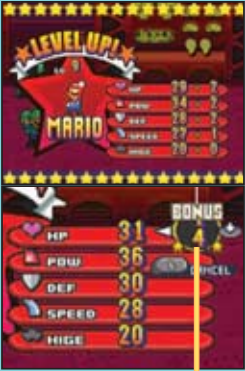
|
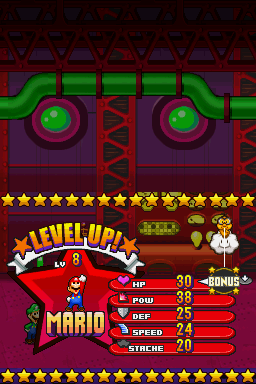
|
At page 27 of the instruction booklet are two images of Mario leveling up, but one of the stats, "Stache", is shown using its Japanese name, "Hige". It’s most likely that the localization team at one point forgot to translate the stat’s name, but ultimately corrected it.
Early English Box Art
| Early | Final |
|---|---|
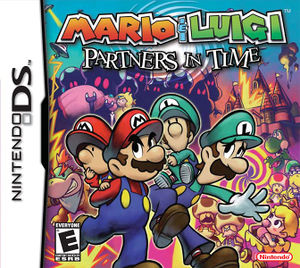
|
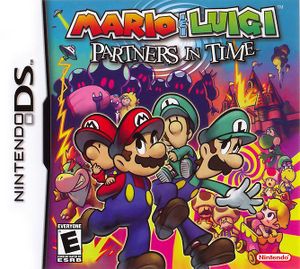
|
An early version of the English box art of the game, which is more zoomed-in and has a wider logo compared to the retail version.
